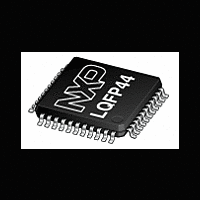XA-C3 NXP Semiconductors, XA-C3 Datasheet - Page 22

XA-C3
Manufacturer Part Number
XA-C3
Description
The XA-C3 is a member of the Philips XA (eXtended Architecture) family of high-performance 16-bit single-chip microcontrollers
Manufacturer
NXP Semiconductors
Datasheet
1.XA-C3.pdf
(68 pages)
Philips Semiconductors
timer register is loaded with FFFF hex. The underflow also sets the
TF2 flag, which can generate an interrupt if enabled.
The External flag EXF2 bit toggles when Timer 2 underflows or
overflows. This EXF2 bit can be used as a 17th bit of resolution, if
needed. the EXF2 bit flag does not generate an interrupt in this
mode. As the baud rate generator, timer T2 is incremented by TCLK.
Baud Rate Generator Mode
By setting the TCLK0 and/or RCLK0 in T2CON, Timer 2 can be
chosen as the baud rate generator for the Transmitter and/or
Receiver sides of UART–0.
Programmable Clock-Out
A 50% duty cycle clock can be programmed to come out on P1.6.
This pin, besides being a regular I/O pin, has two alternate
functions. Either it can be programmed to input the External clock for
Timer/Counter 2 or to output a 50% duty cycle clock.
Table 7. Timer 2 Operating Modes
2000 Jan 25
T2CON[2]
XA 16-bit microcontroller family
32K/1024 OTP CAN transport layer controller
1 UART, 1 SPI Port, CAN 2.0B, 32 CAN ID filters, transport layer co-processor
TSTAT
Bit Addressable
Reset Value: 00H
T2MOD
Bit Addressable
Reset Value: 00H
TR2
0
1
1
1
1
BIT
TSTAT.2
TSTAT.0
BIT
T2MOD.5 RCLK1
T2MOD.4 TCLK1
T2MOD.1 T2OE
T2MOD.0 DCEN
CP or RL2/
T2CON[0]
Address:411
Bits of Special Function Registers
Address:419
X
0
0
1
X
SYMBOL FUNCTION
SYMBOL
T1OE
T0OE
T2CON[5] or T2CON[4]
RCLK0 or TCLK0
Receive Clock Flag.
Transmit Clock Flag. RCLK1 and TCLK1 are used to select Timer 2 overflow rate as a clock source
for UART1 instead of Timer T1.
When 0, this bit allows the T2 pin to clock Timer 2 when in the counter mode.
When 1, T2 acts as an output and toggles at every Timer 2 overflow.
Controls count direction for Timer 2 in autoreload mode.
DCEN=0 counter set to count up only
DCEN=1 counter set to count up or down, depending on T2EX (see text).
FUNCTION
When 0, this bit allows the T1 pin to clock Timer 1 when in the counter mode.
When 1, T1 acts as an output and toggles at every Timer 1 overflow.
When 0, this bit allows the T0 pin to clock Timer 0 when in the counter mode.
When 1, T0 acts as an output and toggles at every Timer 0 overflow.
MSB
MSB
X
0
0
0
1
—
—
Figure 9. Timer 0 and 1 Extended Status (TSTAT)
Figure 10. Timer 2 Mode Control (T2MOD)
—
—
T2MOD[0]
DCEN
RCLK1
X
0
1
X
X
—
15
TCLK1
Timer off (stopped)
16–bit auto–reload, counting up
16–bit auto–reload, counting up or down depending on T2EX pin
16–bit capture
Baud rate generator
—
To configure the Timer/Counter 2 as a clock generator, bit {C2 or
T2/} (T2CON[1]) must be cleared and bit T2OE (T2MOD[1]) must be
set. Bit TR2 (T2CON[2]) also must be set to start the timer.
The Clock–Out frequency depends on the oscillator frequency and
the reload value of Timer 2 capture registers (TCAP2H, TCAP2L) as
shown in this equation:
In the Clock–Out mode Timer 2 roll–overs will not generate an
interrupt. This is similar to when it is used as a baud–rate generator.
It is possible to use Timer 2 as a baud–rate generator and a clock
generator simultaneously. Note, however, that the baud–rate will be
1/8 of the Clock–Out frequency.
2
(65536–TCAP2H, TCAP2L)
—
—
TCLK
T1OE
—
T2OE
—
MODE
DCEN
T0OE
SU00612B
LSB
LSB
Preliminary specification
SU00610B
XA-C3















